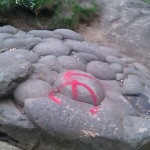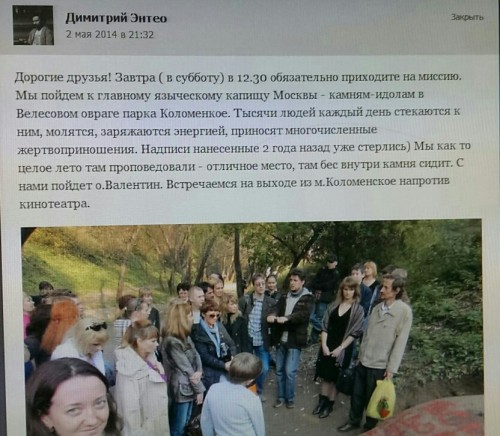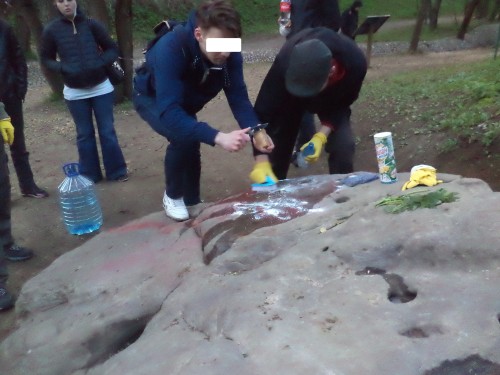
The Maiden stone. Photo credit – Pagan Federation International
On May 3, for the second time in two years, two stones long associated with pagan worship, were vandalized. The stones are located in Kolomenskoye Park in Moscow. Vandals spray painted “This is sin!” and “Idolatry” on the two stones. Area Pagans, who came together to clean the stones, suspect radical Christians for the vandalism. Police and Kolomenskoye Park officials are investigating the crime.
History of the stones
According to Gwiddon, National Coordinator for Pagan Federation International Russia, the two stones have a long history of worship. “The two stones in question, known among the simple folks as the Goose stone and the Maiden (Devichiy) stone, have been brought over by advancing glaciers tens of thousands of years ago from up north and deposited in the Golosov Ovrag [river] when the glaciers finally melted around 12 thousand years ago.” Gwiddon says that there’s archaeological evidence of worship at these stones going as far back five thousand years.
Gwiddon also states that the veneration of these stones has continued to this day, “The trees all around the stones are all covered with ribbon offerings. There is always food left out as offerings as well. People collect water from the nearby brook, considering it holy water.” He says the main reason most people visit the stones is because the stones are said to have healing powers. The Goose stone is alleged to cure illnesses specific to men while the Maiden stone cures infertility and any sort of women’s health concern. The majority of those who currently leave offers or visit the stones for healing are thought to be Christians, although are Pagans do hold special reverence for the stone.
Just over 20 years ago, the Moscow municipal government categorized the stones as “Natural objects under Special Protection”, which carries the same level of protection under the law as a natural preserve or a national park.

The stone being vandalized in 2012, photo from Bozhya Volya social media
Stones repeatedly vandalized
In the summer of 2012, the two stones were vandalized with the phrases “This is sin!” painted on the Goose stone, and “Idolatry is sin” on the Maiden stone. A group of radical young Christians, under the leadership of a man named Enteo, took pictures of the vandalized stones and posted them on the Russian social network VK, which is similar to Facebook. No criminal charges were laid by the administration of Kolomenskoye Park, whose care the stones are under. Shortly after the stones were washed clean by several Pagan activists.
Enteo is the founder of a group called, Bozhya Volya (Will of God), a group suspected of engaging in vandalism and violent acts against political and human rights groups, Pussy Riot supporters, homosexuals, abortion clinics and artists. In 2013 the group petitioned to close a Moscow metaphysical supplies store. The attempt was unsuccessful.

Post by Enteo: Time and date: May 2, 2014 at 21:32 (9:32 pm Moscow time) TRANSLATION: “Dear friends. Tomorrow (Saturday) at 12:30 pm, make sure that you will follow us on a missionary act. We will visit the chief pagan temple in Moscow – idolatory rocks in the Velesov bank in Kolomenskoye Park. Thousands of people visit them daily, pray to them, take energy from them, and leave them offerings. The paint markings put on them two years ago have already vanished We once spent an entire summer there, preaching – this is an excellent place, there is a devil inside that stone. Father Valentine will be there with us. We will meet at the entrance to Kolomenskoye subway station opposite the movie theater.”
On May 2, 2014 Enteo posted on his VK page a call for everyone to gather in Kolomenskoye Park, as the “paint markings put on them two years ago have already vanished.” The post, as translated by Gwiddon, mentions there are demons in the stones, and that he will be accompanied by a priest. Photos of the 2012 vandalism of stones accompanied the post.
The next day the two stones were vandalized again. “This is sin!” was painted on the Goose stone and “Idolatry” was painted on the Maiden stone. Later that evening, Enteo posted on his social media account that someone vandalized the stones, but claims he doesn’t know who is responsible.
Tensions escalate
The Kolomenskoye Park administration, on May 5, claimed that protection of the stones is not under its jurisdiction and that vandalism against natural parks is handled by another government body, Rospprirodnadzor. The Park said it may reassess becoming involved if it receives written statements from citizens along with materials showing who is responsible for vandalizing the stones. This response, along with no mainstream media reports, caused some Pagan concern that an official investigation into the incident would not be forthcoming.
By May 6 eight different Pagan groups decided to clean up the stones, but the groups didn’t appear interested in cooperating with each other. One group set May 10 as the date for Pagans to gather and clean up the stones. Hours later, Enteo posted on social media that Bozhya Volya should gather at the stones on May 10 to stop the Pagans and he also called on all Christians to desecrate all pagan holy sites. These posts were passed around Russian Pagan groups and social media sites. One of the Pagan groups with more nationalistic leanings was especially angered, and concerns surfaced about the potential for a violent clash between nationalist Pagans and the radical Christian group.
Pagan community rallies
Some Pagan groups and individuals didn’t wait for organizing efforts. By the evening of May 6, the paint was mostly scrubbed off. On May 7, another large group of Pagans and eco-activists did a more thorough cleaning of the rocks and and documented the efforts.

Russian Pagans cleaning the stones on May 7th, photo credit Pagan Federation Internation
By May 8, with the need for cleaning the rocks over, the May 10 scheduled cleaning event hosted by Pagans was canceled and tensions reduced. Bozhya Volya has since switched their focus to joining other Orthodox activists in a boycott of the Polish metal group “Behemoth,” which they believe promotes Satanism. Due to the boycott, three Russian cities have canceled Behemoth concerts.
Gwiddon says the act of vandalism, and the conversations in the community about what would be a proper reaction, has brought the fragmented Pagan community closer together, “If anything, this act of vandalism served to solidify the local Pagan community, as literally 2500 people all over Russia actively voiced their disapproval of this act.”
On May 16, the administration of Kolomenskoye Park reported the act of vandalism to the police and they are working together to investigate the crime. Gwiddon says this is a much better response than what happened after the stones were vandalized in 2012.
Police and park officials are presently investigating, but have not made any arrests. The maximum punishment for mishandling the stones is an administrative fine of the equivalent of $100, unless vandalism is proven. Vandalism, in Russia, carries a prison sentence of up to three years.
The Wild Hunt is not responsible for links to external content.
To join a conversation on this post:
Visit our The Wild Hunt subreddit! Point your favorite browser to https://www.reddit.com/r/The_Wild_Hunt_News/, then click “JOIN”. Make sure to click the bell, too, to be notified of new articles posted to our subreddit.
I’d love to know what that archaeological evidence is of millennia-long worship. Seems to me Boyzha Volya, faced with possible direct opposition, shifted to a softer target.Or maybe the prospect of someone seeing the actual depth of their support prompted them to retreat into invisible digital advocacy. Anyway, nice coverage, Cara!
I wouldn’t call Behemoth fans a softer target.
Thanks Baruch – praise is always high coming from you!
“This is why we can’t have any nice things!”
“Radical” Christianity strikes again.
Is it just me, or are these kind of attacks becoming more frequent? If so, does that mean that Paganism (and similar “minority” religions) is being taken more seriously by the wider community?
Possibly, but I think it has more to do the growing strength of a virulent sort of ultra-nationalism within Russia that asserts Christianity and Orthodoxy in particular as part of its core identity.
This movement tends to be homphobic, racist and anti-Semitic, anti-anything that seems Western or decadent or non-conformist in any way. They enforce this through petty, and not-so-petty crimes and do so largely with the tacit approval or indifference of the authorities.
This sort of nationalism is cultivated and tolerated by the Putin regime because its the backbone of his populist appeal. The more thuggish elements also furnish him a nice way to keep dissident groups in check without dirtying official hands too much.
I think it’s further complicated by the fact that some extremist Pagan and Christian groups are fighting over competing visions of hard nationalism and identity politics. I suspect some of it is skinhead-on-skinhead crime, if you will. All of this makes for a very difficult atmosphere for ordinary pagans who just want to do their thing in peace.
Thank you for the detail in this– you beat me to the reply, but did it much better than I could. There’s also definite American Dominionist export meddling in Russia, too. I don’t know that it’s proof of Paganism being taken more seriously, but it’s definitely proof that in governance climates where it can get away with it, this theocratic movement shows exactly what it wants and what it’s capable of doing.
When I say “taken more seriously”, what I mean is that numbers are increasing at a time when Christianity is (overall) showing something of a decline. To the point where it is becoming increasingly difficult to just brush various non-Christian practices aside as irrelevant.
On the other hand, I see that Hindus are looking to establish interfaith with non-Christian traditions (notably those that are “indigenous European”).
In short, people are hearing the Pagan voice now, and not all of them like it.
A Hindu of some note had a saying about this very thing.
“First they ignore you, then they laugh at you, then they fight you. Then you win.”
In Russia and elsewhere, the Pagan movement is too big for reactionary forces to ignore, and we’re well past their stunted sense of humor, so it’s down to fighting.
I agree entirely.
Christianity is not declining in numbers in the developing world. In the developing world, which is where most of the world’s population is, Roman Catholicism is holding steady via natural increase; Evangelical Protestantism is gaining numbers through vigorous proselytizing in Asia, Latin America and Africa; and Orthodox Christianity is having a moderate resurgence in Slavic countries. The Mormons, if you count them as Christians, are holding their own. The only churches numerically declining are the mainline Protestant denominations (which no longer proselytize) and Christian Science.
In Africa, Islam is also expanding in numbers at the expense of indigenous religions.
Declining overall numbers of Christian adherents is a phenomenon of wealthy Western nations.
I wouldn’t call Japan “majority Pagan”.
I can only go by what I hear and read. It could be that my sources are focused on the economically developed countries (EDCs), but the point is still valid in appearance.
According to various sources (mainly wikipedia, though I did check their sources), Japan is approx. 1/3 Buddhist, though a majority profess no religious affiliation.
Indeed. I wouldn’t call Buddhism “Pagan”.
I was talking wider than just Russia. An increasing amount of Pagan (and similar) news is about attacks (by Christians) against perceived “Pagan” activity.
In an increasingly pluralistic global society, Paganisms are some of the loudest voices calling for recognition.
Making yourself a visible target is a risky business.
I’ll talk to Gwiddon about there being anything in translation or on the
internet. There is massive amounts of archeological texts from Imperial
and Soviet Russia that exist only off-line and in Russian. This is
obscure enough I don’t even know where to start.
Thanks, Anthony – I know the information is out there, but I don’t read Russian.
Thanks, Carla and Wild Hunt for this story. Sad how terrified the members of some religions are of anyone who doesn’t worship “their” god.
That is a rather pathetic commentary on their own belief structure, isn’t it? Fear has long been a guiding principle in some of the dominant paradigm faiths — and the unfortunate side effect of fearing your god is you also fear damned near every thing else, too. And so, in fear of competition they act in such violent ways rather than considering accepting, as Matthew Fox once said, “that there is one river, and many wells.”